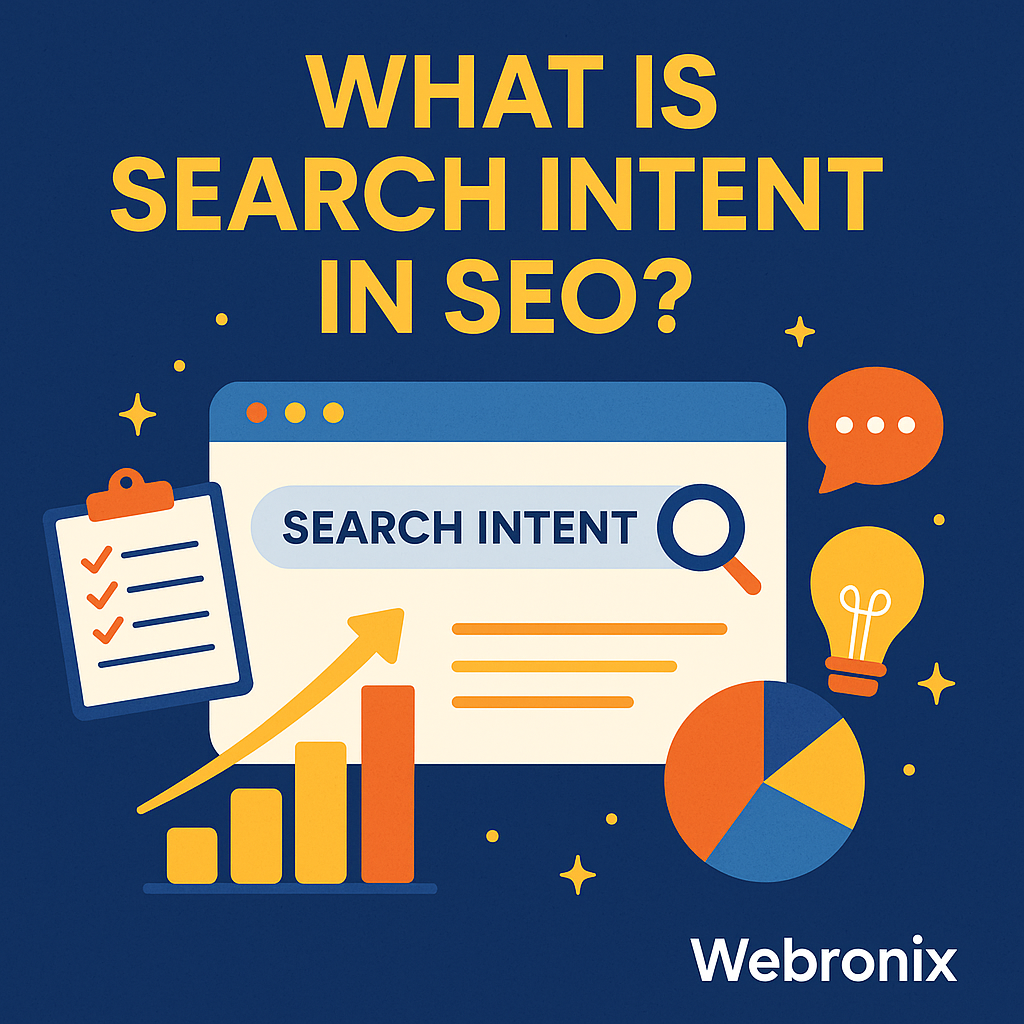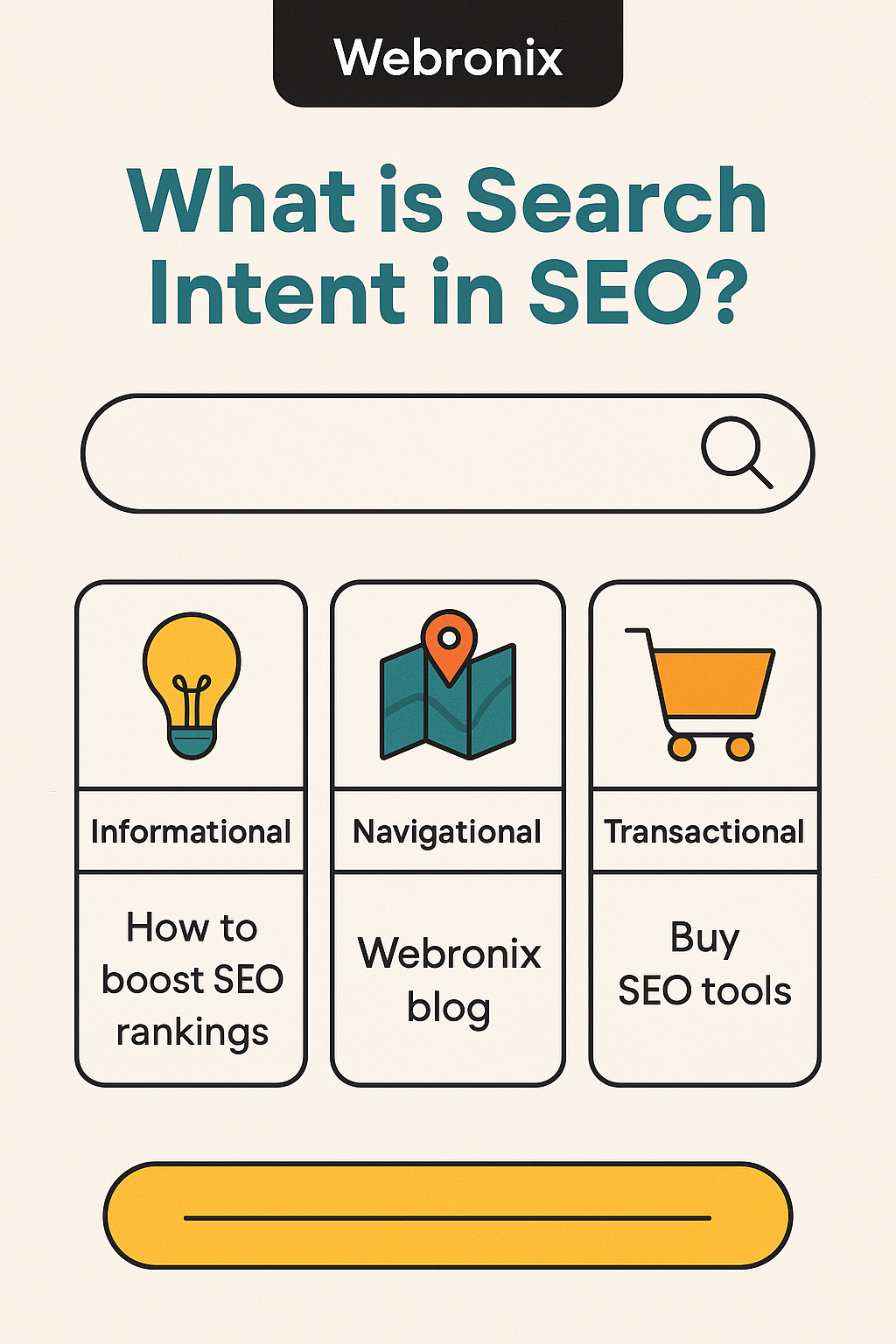What Is Search Intent in SEO, What It Is & How To Optimize-By Webronix
Introduction to Search Intent
In today’s cutthroat digital landscape, knowing search intent is one of the main driving forces in effectively implementing SEO. For marketers or businesses that are trying to succeed online, search engine optimization is so much more than just keyword placement or link profiling; it is understanding the underlying intent of a user query.
Search intent, also often referred to as user intent, refers to a user’s reason or purpose for searching online. When someone types something into Google, they are not just looking for words; they are looking for an output that will solve a problem or need.
At Webronix, a leading digital marketing agency, we show clients and prospects every day how, when their content is aligned with the correct search intent, they can grow exponentially in terms of traffic and conversions. Let’s take a closer look at what search intent is, what it is important, and how to properly optimize for it.
What is Search Intent and why do I need to understand this?
Search intent is the motive behind the user performing a search query in a search engine. Search intent is composed of the actual words entered in the search box on a search engine, but it also considers what the user expects to find at the end of the query. Search intent is always in some way related to a user’s needs—they either want to purchase something, they are looking for information, or they need to find a service.
For example:
Someone who searches “best laptops under 50000” probably wants to buy it and is looking for reviews of the products.
“What is digital marketing?” is a pretty clear case of seeking a specific piece of information. A lot of people might ask questions like that.
In search of “digital marketing agency near me” could indicate an implied need to act.
Search engines like Google exist to accurately satisfy the intent of the user as best as possible. This is why understanding search intent is so important with regard to an SEO strategy.
Types of Search Intent
To optimize for search intent, it is important to first understand the four types of search intent. Each of these search intents is a representation of the user journey stage.
Informational Intent
Users with informational intent are looking to learn. They are not ready to buy just yet; they are starting their research.
Examples
“How to improve SEO ranking”
“What is search intent?”
“Benefits of digital marketing”
Navigational Intent
Users already know what they are looking for and are trying to get to specific web page or website. These searches are focused on a brand.
Examples
“Facebook log in”
“Webronix blog”
“Moz SEO guide”
Transactional Intent
Users who have transactional intent are ready to take action, buy something, subscribe to something, or sign up for something. These users are at the bottom of the funnel.
Examples
“Buy DSLR online”
“Cheap hosting services”
“Subscribe to marketing tools.”
Commercial Investigation
This is a mix of informational and transactional intent. Users want to compare products, investigate reviews, and see that they are making the best decision before pulling the trigger on buying something.
Examples
“Best SEO tools compared”
“Webronix vs other agencies”
“Top social media schedulers 2025”
Why should search intent matter to SEO?
Searching for intent has ultimately become the focus of SEO today. If your content does not match what users want, even having high rankings can lead to extreme disappointment.
Improves user experience
When content matches the user’s search intent, it meets their expectations, thus yielding lower bounce rates, higher time on site, and higher dwell time; all of which are dominant ranking factors.
Boosts relevance – search rankings
Search engines use AI (Google BERT) to understand context, not just keywords. Content that correctly matches search intent will rank higher.
Higher conversion – increases conversion rates
If a user is ready to purchase and your webpage aligns with that intent and has only relevant CTAs and supporting information, your conversion rates will go through the roof!
Content strategy
Understanding keyword intent is vital. Content creators can visualize a funnel where user intent runs the range from awareness (informational) to purchase (transactional) and the myriad of stages in between.
How Google Understands Search Intent
When users interact with the search results, search engines measure behavioral signals like:
Clicks
Time on page
Bounce rate
Repeat visits
Also, Google uses Natural Language Processing (NLP) to analyze search intent to understand semantic meaning. It helps to determine search intent when there is ambiguity.
For example, in the query “apple”:
the fruit (informational)
The brand (navigational)
Apple Store (transactional)
Google is looking at how users are interacting with the results and changing the adjustments they make.
How to Discern Search Intent for Keywords
Before creating content, it’s essential to analyze what type of intent lies behind a keyword.
Examination of Search Engine Results Pages
The results of Google’s first page could point to:
Are the top results blog posts? (Informational)
Are they product pages? (Transactional)
Are they category pages, or are they reviews? (Commercial)
Find modifiers that denote specific intents
Some words point to certain intents:
Informational: how, what, guide, tips, tutorial
Navigational: brand names, login, homepage
Transactional: buy, discount, order, pricing
Commercial: best, compare, review, top 10
Try Using Tools: Like SEMrush, Ahrefs, Ubersuggest
With features for directory searches, certain tools may help one understand keyword intent:
SERP features
CPC values (higher CPC value pointed for transactional)
Related keywords
Optimizing Content for Search Intent
To align content with search intent, you’ll have to strategically create content and optimize on-page elements.
Match the Content Format with the Search Intent
For informational search intent:
Use guides, how-tos, lists
For transactional search intent:
Use product pages, landing pages, and service pages
For commercial intent:
Use comparison blogs, case studies, and expert reviews
For navigational search intent:
Optimize for the brand pages or resource the user is looking for
Match the Language and Tone to the Intent
Informational: Friendly and helpful, educational
Transactional: Persuasive and benefit-focused
Commercial: Analytical, comparative, trustworthy
Navigational: Straightforward and to the point
Match the Meta Tags to the Intent
It is critical that your title tag and meta description fit the various search intents so you can improve your CTR and relevancy.
Use Rich Snippets and Schema
It is important that your title tag and meta description match the various search intents so that you get increased CTR and relevancy.
Utilize FAQ, How-To, and Product schemas to help Google understand the content type and serve it in style effectively to match search intent.
Good Examples of Search Intent Optimization
Example 1: Informational Blog
Keyword: How to improve SEO rankings
A blog post explaining best practices for on-page SEO, with examples, and downloadable checklists would be a great fit. This meets informational intent.
Example 2: Transactional Page
Keyword: “Purchase a digital marketing course”
A landing page with pricing, features, CTAs, and testimonials (if applicable) would be the perfect match.
Mistakes With Targeting Search Intent
- Forcing Keywords Into Wrong Intent. One example is creating a product page for an informational query. This can rank poorly and convert poorly, too.
- Ignoring the Funnel Stage. All intent relates to a stage of the marketing funnel. Using keywords regarding intent at the wrong stage can muddle the user journey.
- Keyword Stuffing Although we are matching intent, if we don’t use the term search intent NATURALLY, it will hurt ranking. Just use the term naturally, serving the relevant intent.
Intent and Your Content Strategy
By mapping your content to the customer journey by intent, you ensure your blog, service, or product page is always serving a real need.
Awareness: Informational Content
Consideration: Commercial/Investigative
Conversion: Transactional Content
This flow is critical in converting HTML SEO traffic into real business outcomes.
Resources for Exploring Search Intent
Google Search Console: Review click data per query.
SEMrush and Ahrefs: SERP analysis and intent tagging.
Answer the Public: Used for informational queries.
SurferSEO: Analyzing the top content by intent.
Google Trends: Allows tracking shifts in intent over time.
How Search Intent Affects Voice Search & AI
Search intent has become more conversational with voice search.
For example:
“What is the best restaurant to get to near me?”
“How do I fix the internet?”
Optimizing for conversational search takes more accuracy to align content to intent.
AI tools such as ChatGPT and Google’s SGE(Search Generative Experience) sharpen results to indicate and predict intent with more precision than before.
Optimizing Search Intent for E-Commerce
E-commerce brands can significantly improve SEO by:
Mapping keywords to intentCreating a page for each intent
Having a usable way to filter and sort products
Creating comparison content that has transactional CTAs
Mobile SEO and Search Intent
Mobile users often have urgent needs (local, transactional), so your content must:
Load fast
Provide unambiguous CTAs
Be easy to navigate
Wrap-Up on Search Intent and SEO
Understanding search intent and optimizing for it is an obligation now.
No matter if you are a blogger, an e-commerce seller, SaaS business, or a digital agency (e.g. Webronix), if you remain aligned to user intent, SEO is not just a ranking exercise but rather providing a worthwhile experience for the user.
Key Points
Search intent is the link between searchers and solutions. Where viable content meets what the user wants. By examining and strategically aligning search intent to your SEO approach, you are additionally emphasizing relevance, trust, and revenue. You are not simply competing for rankings.
At Webronix we promote intent-driven marketing. With the right content and the right user intent, your brand can break through the noise and stand out at the top of organic search results.









